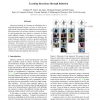Free Online Productivity Tools
i2Speak
i2Symbol
i2OCR
iTex2Img
iWeb2Print
iWeb2Shot
i2Type
iPdf2Split
iPdf2Merge
i2Bopomofo
i2Arabic
i2Style
i2Image
i2PDF
iLatex2Rtf
Sci2ools
CVPR
2011
IEEE
2011
IEEE
Learning invariance through imitation
Supervised methods for learning an embedding aim to map high-dimensional images to a space in which perceptually similar observations have high measurable similarity. Most approaches rely on binary similarity, typically defined by class membership where labels are expensive to obtain and/or difficult to define. In this paper we propose crowdsourcing similar images by soliciting human imitations. We exploit temporal coherence in video to generate additional pairwise graded similarities between the user-contributed imitations. We introduce two methods for learning nonlinear, invariant mappings that exploit graded similarities. We learn a model that is highly effective at matching people in similar pose. It exhibits remarkable invariance to identity, clothing, background, lighting, shift and scale.
Binary Similarity | Computer Vision | CVPR 2011 | Pairwise Graded Similarities | Similar Observations |
| Added | 08 Apr 2011 |
| Updated | 29 Apr 2011 |
| Type | Journal |
| Year | 2011 |
| Where | CVPR |
| Authors | Graham Taylor, Ian Spiro, Rob Fergus, Christoph Bregler |
Comments (0)

